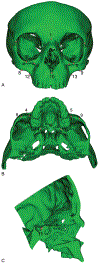Midface Morphology and Growth in Syndromic Craniosynostosis Patients Following Frontofacial Monobloc Distraction
- PMID: 33136785
- PMCID: PMC8011493
- DOI: 10.1097/SCS.0000000000006997
Midface Morphology and Growth in Syndromic Craniosynostosis Patients Following Frontofacial Monobloc Distraction
Abstract
Background: Facial advancement represents the essence of the surgical treatment of syndromic craniosynostosis. Frontofacial monobloc distraction is an effective surgical approach to correct midface retrusion although someone consider it very hazardous procedure. The authors evaluated a group of patients who underwent frontofacial monobloc distraction with the aim to identify the advancement results performed in immature skeletal regarding the midface morphologic characteristics and its effects on growth.
Methods: Sixteen patients who underwent frontofacial monobloc distraction with pre- and postsurgical computed tomography (CT) scans were evaluated and compared to a control group of 9 nonsyndromic children with CT scans at 1-year intervals during craniofacial growth. Three-dimensional measurements and superimposition of the CT scans were used to evaluate midface morphologic features and longitudinal changes during the craniofacial growth and following the advancement. Presurgical growth was evaluated in 4 patients and postsurgical growth was evaluated in 9 patients.
Results: Syndromic maxillary width and length were reduced and the most obtuse facial angles showed a lack in forward projection of the central portion in these patients. Three-dimensional distances and images superimposition demonstrated the age did not influence the course of abnormal midface growth.
Conclusion: The syndromic midface is hypoplastic and the sagittal deficiency is associated to axial facial concavity. The advancement performed in mixed dentition stages allowed the normalization of facial position comparable to nonsyndromic group. However, the procedure was not able to change the abnormal midface architecture and craniofacial growth.
Copyright © 2020 by Mutaz B. Habal, MD.
Conflict of interest statement
The authors report no conflicts of interest.
Figures





Similar articles
-
Three-dimensional image analysis of facial skeletal changes after monobloc and bipartition distraction.Plast Reconstr Surg. 2008 Jul;122(1):225-231. doi: 10.1097/PRS.0b013e3181774308. Plast Reconstr Surg. 2008. PMID: 18594409
-
Comparison of Internal and External Distraction in Frontofacial Monobloc Advancement: A Three-Dimensional Quantification.Plast Reconstr Surg. 2023 Sep 1;152(3):612-622. doi: 10.1097/PRS.0000000000010331. Epub 2023 Feb 28. Plast Reconstr Surg. 2023. PMID: 36847681
-
Craniosynostosis: Monobloc Distraction with Internal Device and Its Variant for Infants with Severe Syndromic Craniosynostosis.Clin Plast Surg. 2021 Jul;48(3):497-506. doi: 10.1016/j.cps.2021.02.008. Epub 2021 May 8. Clin Plast Surg. 2021. PMID: 34051901 Review.
-
Fronto-facial monobloc distraction in syndromic craniosynostosis. Three-dimensional evaluation of treatment outcome and facial growth.Int J Oral Maxillofac Surg. 2012 Jan;41(1):20-7. doi: 10.1016/j.ijom.2011.09.012. Epub 2011 Nov 16. Int J Oral Maxillofac Surg. 2012. PMID: 22094394
-
Subcranial Midface Advancement in Patients with Syndromic Craniosynostosis.Oral Maxillofac Surg Clin North Am. 2022 Aug;34(3):467-475. doi: 10.1016/j.coms.2022.01.002. Epub 2022 Jul 2. Oral Maxillofac Surg Clin North Am. 2022. PMID: 35787822 Review.
Cited by
-
Three-Dimensional Evaluation of Dental Arches in Individuals with Syndromic Craniosynostosis.Int J Dent. 2023 Jan 7;2023:1043369. doi: 10.1155/2023/1043369. eCollection 2023. Int J Dent. 2023. PMID: 36647423 Free PMC article.
References
-
- Fearon JA, Podner C. Apert syndrome: evaluation of a treatment algorithm. Plast Reconstr Surg 2013;131:132–142 - PubMed
-
- Fearon JA, Rhodes J. Pfeiffer syndrome: a treatment evaluation. Plast Reconstr Surg 2009;123:1560–1569 - PubMed
-
- Fearon JA, Whitaker LA. Complications with facial advancement: a comparison between the Le Fort III and monobloc advancements. Plast Reconstr Surg 1993;91:990–995 - PubMed
-
- Gwanmesia I, Jeelani O, Hayward R, et al. Frontofacial advancement by distraction osteogenesis: a long-term review. Plast Reconstr Surg 2015;135:553–560 - PubMed
-
- Witherow H, Dunaway D, Evans R, et al. Functional outcomes in monobloc advancement by distraction using the rigid external distractor device. Plast Reconstr Surg 2008;121:1311–1322 - PubMed
MeSH terms
Grants and funding
LinkOut - more resources
Full Text Sources

